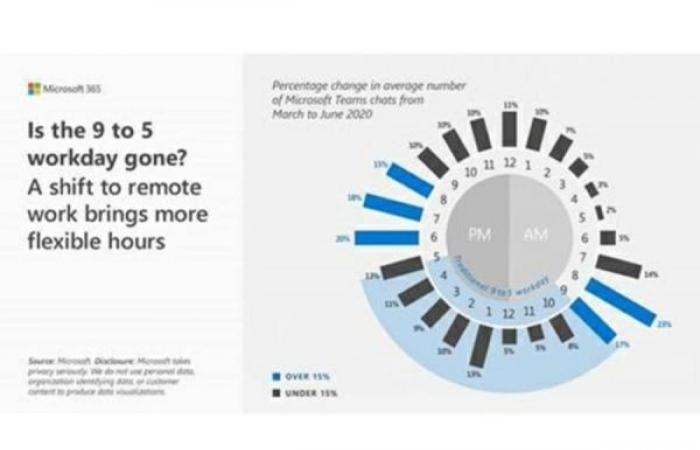We show you our most important and recent visitors news details Remote Working Findings — doing better with Microsoft Teams in the following article
Hind Al Soulia - Riyadh - NEW YORK — The latest Microsoft Work Trend Index Report combined three sources to create current insights on this trend, specifically customer trends in use of tools, Harris Poll survey findings from a panel of 2,000 workers across 6 countries, and 30 of Microsoft’s own research projects across the company.
The purpose of this Work Trend Index Report was to understand the remote worker experience. One aspect that remained consistently reported across all three sources was the challenge of remote workers becoming more tired than comparable in-person work.
The second report released by Microsoft on the Business Trends index was recently released, with findings from the research being gained from a range of various sources. The purpose of this report was to understand the remote worker experience over the pandemic period since the start of COVID-19, and in order to re-visualize future trends in working, as well as work-life balance.
The research pointed to the likelihood that the traditional 9 to 5 working pattern might disappear over time, due in large part to the flexibility in working from home that has been gained in the last few months. Microsoft Teams created insight which shows that people often work morning and evening hours, and weekends, but tend to avoid the traditional mid-day work routine.
The study also noted a question of whether bricks and mortar offices will be on the decline with remote work futures, since most of the workforce that is able to work is doing so remotely over the last few months.
About 82% of respondents expect to continue the flexible work from home policy after the pandemic ends, and 71% of employees and managers alike reported their desire to continue working from home at least on a part-time basis.
“Our goal for this research is to uncover both good and challenging aspects of remote work so we can accelerate product development in the right areas, anticipate how work will change in the future, and help our customers thrive in this new world of work,” said Jared Spataro, corporate vice president for Microsoft 365.
Microsoft also ran studies in the Human Factors Labs to focus on the interaction humans have with technology and how brains respond to remote collaboration through computer screens compared to working together in-person. The study focused on 13 pairs of a remote worker and an in-person worker wearing EEG devices to monitor brainwave changes.
The studies found remote workers to be more challenged, with stress and overwork showing in remote worker’s brainwaves faster than in their in-person worker counterparts. Interestingly, the study found that when workers worked together remotely in the first instance they found in more stressful to work in-person with others later on, which shows that there could be issues with employees returning to normal in-person working conditions as it did prior to COVID-19.
Brainwave studies have also found that stress and overwork markers are much higher at times of video meetings as compared to email writing correspondence.
Microsoft studies found that fatigue for a remote worker can set in within 2 hours of taking video meetings, with research suggesting factors such as focusing on the screen for long periods of time to gain information at the core of the stress. Also included as reasons for remote worker stress is the lack of non-verbal cues which are gained within an in-person working environment.
Findings capture in the Work Trends Report included seeing an integration of new applications within remote working software throughout the pandemic, with Windows Teams have releasing updates to create a higher human connection level across the remote worker team, namely the Dynamic View, and the Together Mode.
Dynamic view is an AI enhanced meetings which can dynamically share information between video participants. Together mode is a Teams meeting experience option that uses AI segmentation technology which digitally places participants in one shared background. The view adds a feel that the team is sitting in the same room, which is useful for brainstorming sessions.
The report found that use of Microsoft Teams software has hit an all time high, with 2.7 billion meeting minutes in one day alone, representing a 200% increase since mid-March. Distance learning teams have also greatly increased with 183,000 tenants in 175 countries currently using the Microsoft Teams for Education software.
The recent Microsoft Work Trend Index Report also showed that video calls in the Microsoft Teams environment have exploded since March 2020.
In general, the report explored the various ways in which employees, managers, and teams connect online to accomplish their working day. The findings have shown that there are both advantages and disadvantages to working remotely, with the major advantage being increased flexibility with schedules and the major disadvantage being stress related.
As people have learned to develop their individual and group remote working strategies, the report found a strong desire to see a portion of their post-pandemic working day inclusive of some remote working flexibility. — SG
These were the details of the news Remote Working Findings — doing better with Microsoft Teams for this day. We hope that we have succeeded by giving you the full details and information. To follow all our news, you can subscribe to the alerts system or to one of our different systems to provide you with all that is new.
It is also worth noting that the original news has been published and is available at Saudi Gazette and the editorial team at AlKhaleej Today has confirmed it and it has been modified, and it may have been completely transferred or quoted from it and you can read and follow this news from its main source.





